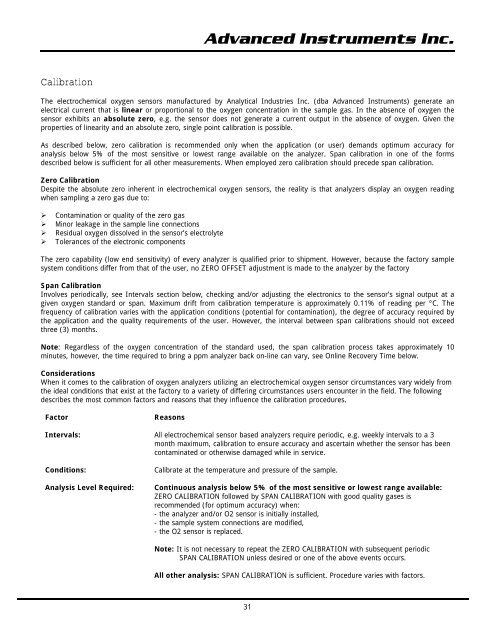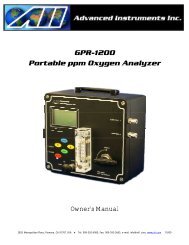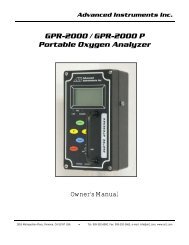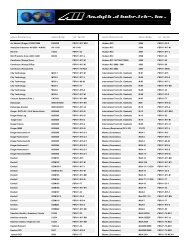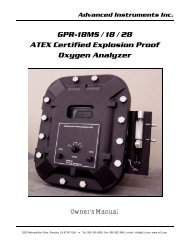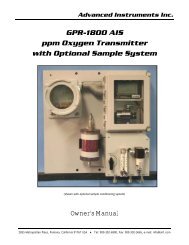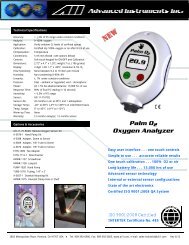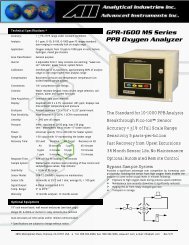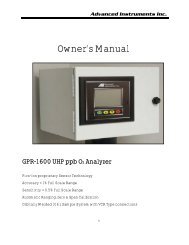GPR-2600 Series Oxygen Analyzer - Advanced Instruments Inc.
GPR-2600 Series Oxygen Analyzer - Advanced Instruments Inc.
GPR-2600 Series Oxygen Analyzer - Advanced Instruments Inc.
You also want an ePaper? Increase the reach of your titles
YUMPU automatically turns print PDFs into web optimized ePapers that Google loves.
<strong>Advanced</strong> <strong>Instruments</strong> <strong>Inc</strong>.CalibrationThe electrochemical oxygen sensors manufactured by Analytical Industries <strong>Inc</strong>. (dba <strong>Advanced</strong> <strong>Instruments</strong>) generate anelectrical current that is linear or proportional to the oxygen concentration in the sample gas. In the absence of oxygen thesensor exhibits an absolute zero, e.g. the sensor does not generate a current output in the absence of oxygen. Given theproperties of linearity and an absolute zero, single point calibration is possible.As described below, zero calibration is recommended only when the application (or user) demands optimum accuracy foranalysis below 5% of the most sensitive or lowest range available on the analyzer. Span calibration in one of the formsdescribed below is sufficient for all other measurements. When employed zero calibration should precede span calibration.Zero CalibrationDespite the absolute zero inherent in electrochemical oxygen sensors, the reality is that analyzers display an oxygen readingwhen sampling a zero gas due to:‣ Contamination or quality of the zero gas‣ Minor leakage in the sample line connections‣ Residual oxygen dissolved in the sensor’s electrolyte‣ Tolerances of the electronic componentsThe zero capability (low end sensitivity) of every analyzer is qualified prior to shipment. However, because the factory samplesystem conditions differ from that of the user, no ZERO OFFSET adjustment is made to the analyzer by the factorySpan CalibrationInvolves periodically, see Intervals section below, checking and/or adjusting the electronics to the sensor’s signal output at agiven oxygen standard or span. Maximum drift from calibration temperature is approximately 0.11% of reading per °C. Thefrequency of calibration varies with the application conditions (potential for contamination), the degree of accuracy required bythe application and the quality requirements of the user. However, the interval between span calibrations should not exceedthree (3) months.Note: Regardless of the oxygen concentration of the standard used, the span calibration process takes approximately 10minutes, however, the time required to bring a ppm analyzer back on-line can vary, see Online Recovery Time below.ConsiderationsWhen it comes to the calibration of oxygen analyzers utilizing an electrochemical oxygen sensor circumstances vary widely fromthe ideal conditions that exist at the factory to a variety of differing circumstances users encounter in the field. The followingdescribes the most common factors and reasons that they influence the calibration procedures.FactorReasonsIntervals: All electrochemical sensor based analyzers require periodic, e.g. weekly intervals to a 3month maximum, calibration to ensure accuracy and ascertain whether the sensor has beencontaminated or otherwise damaged while in service.Conditions:Analysis Level Required:Calibrate at the temperature and pressure of the sample.Continuous analysis below 5% of the most sensitive or lowest range available:ZERO CALIBRATION followed by SPAN CALIBRATION with good quality gases isrecommended (for optimum accuracy) when:- the analyzer and/or O2 sensor is initially installed,- the sample system connections are modified,- the O2 sensor is replaced.Note: It is not necessary to repeat the ZERO CALIBRATION with subsequent periodicSPAN CALIBRATION unless desired or one of the above events occurs.All other analysis: SPAN CALIBRATION is sufficient. Procedure varies with factors.31


